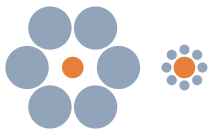Fundamentals of Neuroscience/Sight
Goals[edit | edit source]
The Eye[edit | edit source]Vision, like all senses, starts with an external stimulus. In this case, the raw information being taken in from the world is in the form of photons of light, whose frequencies, wavelengths, and intensity code information ranging from color to depth. As light enters the eye through a hole called the pupil, it becomes bent or refracted by the lens. The purpose of this refraction is to focus the beams of light entering the eye onto the retina. The retina is a thin screen made up of photoreceptors at the back of the eye onto which an image projects. It is with these photoreceptors that the neuroscience aspect truly begins. Photoreceptors are divided into two generally types- rods and cones. rod cells are by far the predominant variant (making up around 95% of all photoreceptors) and are extremely sensitive to stimulation by light- including at very dim levels and at the periphery of the visual field- although they are incapable of distinguishing between colors. In contrast, cone cells respond differently depending on the wavelength of light that they detect and thereby allow for color vision (since a light wave's wavelength determines what color it is in the visible spectrum). In addition, cone cells can extract much more detailed information about an image, which is why they are concentrated in the center of one's gaze, where visual acuity is greatest. The photoreceptors of the retina send out the visual information they acquire via the optic nerve. As the two optic nerves (one from each eye) pass toward their ultimate destination of the occipital lobe in the back of the head, they cross and exchange connections so that one nerve fiber carries information exclusively about the left field of vision, and the other nerve carries information exclusively about the right field of vision. The Visual Cortex[edit | edit source] The visual cortex begins with the primary visual cortex, also known as V1, at the very back of the occipital lobe, and then radiates outward to progressively higher and more sophisticated levels of processing. By only this first level of V1, the raw visual input from the world has only undergone minimal processing- detecting broad qualities like motion or brightness. V1 extracts even more information, up to the level of basic spatial characteristics and low-level properties of an image. This information is then passed on to V2, which begins to assimilate specific sights into shapes and patterns. At increasingly higher levels (V3 up to V6), other information is extracted, including orientation of an object, direction of movement, color, and finally depth. Most of these higher-tiers of processing require combining disparate visual cues in complex ways in order to produce a simple conscious quality. For example, depth can only be extracted indirectly based on certain visual cues, such as shadow effects and juxtaposing the slightly different images produced by either eye. Completing Perception[edit | edit source] Once the raw data obtained by the eyes is extracted and processed into detailed visual information, the final stage is to take that information and essentially interpret it into something useful. The two areas where this task is most apparent is in one's spatial awareness and in object recognition. The spatial pathways primarily rely on the parietal lobe to perform the calculations of distance, motion, and spatial-relationships based on the partially processed visual information it receives from the outer layers of the visual cortex. In contrast, the recognition pathways usually demand more well-processed visual information, and is thus slightly slower but better correlated to directly conscious awareness. Images here can be scanned for emotional saliency and can be compared to memories in order to spark recognition. | |||||
